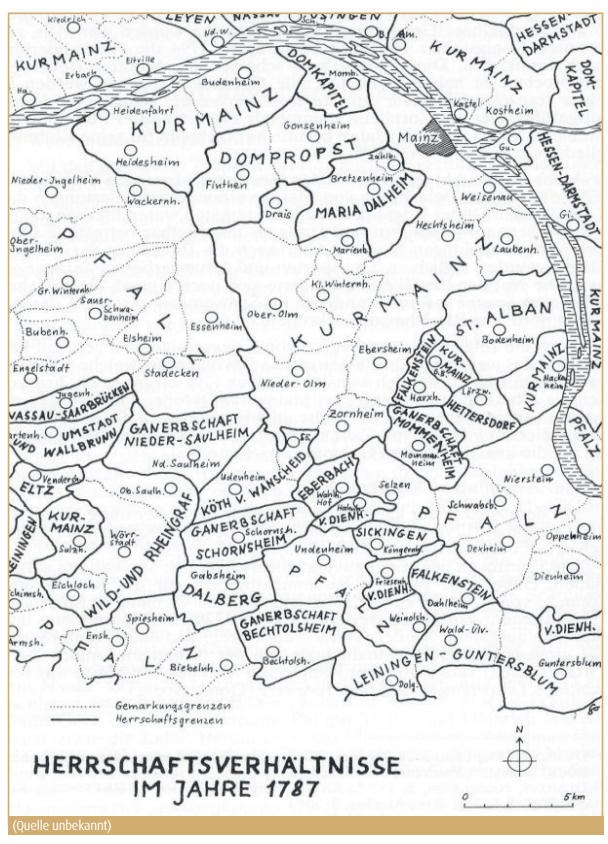Rheinhessen’s history before 1816
Favorable climatic conditions and the Rhine as a traffic artery have attracted people to Rheinhessen at all times. Thus, the region called Rheinhessen since 1816 has also experienced eventful times long before that.
First settlements existed in Rheinhessen already between 4000 – 2000 B.C. Around 500 – 100 B.C. the Celts founded the first settlements. After that, Rheinhessen was under Roman rule for about 500 years until about 460 AD. The Romans left numerous traces and, among other things, brought wine to our region. After the Romans, the Franks took over the rule. Many places in Rheinhessen were founded by them, easily recognizable by the place ending “-heim”. Christianization also began with the Franks.
In the 9th century, the Frankish Empire was divided, and from the eastern territories emerged the Holy Roman Empire with Emperor Otto I in 962. This empire lasted for a long time and only perished in 1806 under Napoleon’s warlike pressure. Characteristic of the Holy Roman Empire was its strong fragmentation into small states formed over centuries. One of the main reasons for this was the feudal system, in which wealthy feudal lords gave parts of their property to loyal feudalists. Over time, this property became hereditary.
In our region, especially the Archbishop of Mainz and the Count Palatine were able to build up considerable territories. Thus they developed into powerful and influential rulers. In the 13th century they were given the right to elect the king of the Holy Roman Empire. This right was connected with the title of an elector (at first there were seven electors, their number later grew up to ten). This further increased their influence. Besides these powerful electors, however, there were many smaller rulers in Rheinhessen. In 1789, the territory of today’s Rheinhessen counted 190 municipalities. Of these, 92 belonged to the Electoral Palatinate, 40 to Electoral Mainz, and the remaining 58 communities to 32 other sovereigns. At that time Harxheim belonged to the county of Falkenstein, which also held the dominion in Dalheim, Biebelsheim, Eckelsheim, Framersheim and Hillesheim. All the communities bordering Harxheim thus had other authorities.
In 1517 the Reformation began. Some sovereigns, such as the Palatine Elector and also the Count of Falkenstein, then changed their faith and introduced it in their territories as well. This further exacerbated the fragmentation in Rheinhessen. Harxheim and Mommenheim, for example, became Lutheran, whereas the surrounding communities remained true to the old faith. Remarkably, however, in Rheinhessen there were no expulsions of believers as elsewhere. In many cases – as in Harxheim – simultaneous churches were built, i.e. church buildings used jointly by two denominations.
Its location on the “thoroughfare” of the Rhine meant that Rheinhessen was repeatedly the scene of armed conflicts over the centuries. The proximity to France and the frequent territorial conflicts with the French neighbor were also momentous. Particularly devastating was the War of the Palatinate Succession (1688 – 1697), with which Louis IV of France – the Sun King – wanted to enforce territorial expansions to the east. Many Rhine-Hessian communities suffered great destruction in this war.
Times of upheaval after the French Revolution
After centuries of small states in the Holy Roman Empire, the French Revolution of 1789 and its consequences represented a striking break for the area of today’s Rheinhessen. The overthrow of the old powers in France triggered the Revolutionary Wars between France on one side and Austria and Prussia on the other. The latter wanted to prevent revolutionary thoughts from leading to overthrow in their areas of power as well. In the course of the wars, the French permanently conquered the area on the left bank of the Rhine from 1794. In 1792/93, they were even able to take Mainz for a short time, which led to the founding of the Mainz Republic, the first democratic state on German soil. Since Mainz was retaken by the Prussians in July 1793, it had only a short life span from March to July 1793.
In the Peace of Campo Formio in 1797, France was granted the territories on the left bank of the Rhine, and today’s Rhine Hesse thus became French from 1798 to 1814. This had massive consequences across all strata of the population. Our region was divided into eleven cantons, which belonged to the Département Mont Tonnère (Départment Donnersberg). Harxheim belonged to the canton of Nieder-Olm. The French introduced a unified and streamlined administration. State and church were separated. People were given more freedoms and rights. Feudal taxes such as tithes were abolished, serfdom was abolished and freedom of trade was introduced. Jurisdiction was reformed and unified with the entry into force of the Code civil in 1804. Monasteries and churches lost their property during secularization.
The new era ushered in by the French had not only positive consequences for the people. In the end, however, they obviously learned to appreciate the new freedoms and were not prepared to give them up again in 1816 as a result of their now belonging to the Grand Duchy of Hesse. This becomes clear from the assurance of the Hessian Grand Duke Ludwig I, which he gave in the following passage of the deed of possession, published on July 11, 1816, in the Grand Ducal Hessian Newspaper: “Remnants of the feudal system, the tithes and the frohnden, are and will remain suppressed in these lands; the truly good, which brings about enlightenment and contemporary conditions, will continue to exist”. In fact, the following decades in Rheinhessen – as elsewhere – were marked by the Restoration and the striving against it for democracy and a German nation state.
Wie es mit Rheinhessen weiterging und wofür Rheinhessen heute steht, kann man hier lesen …
References:
Rettinger, Elmar (2005). The Mainz-Bingen district in history. https://www.regionalgeschichte.net/fileadmin/Superportal/Bibliothek/RettMainzBingen2005.pdf
Rick, Josef (1967): Weinbaugemeinde Harxheim. In: Gemeinde Harxheim (Hrsg.): Festschrift. 1200 Jahre Weinbaugemeinde Harxheim.
www.regionalgeschichte.net/bibliothek/aufsaetze/grathoff-geschichte-rheinhessens.html

